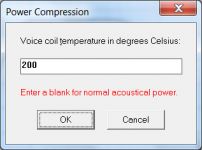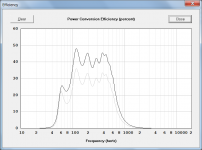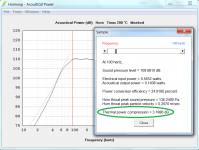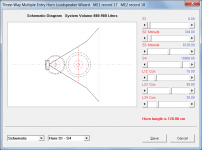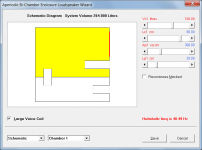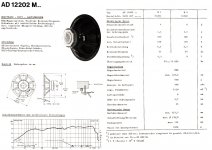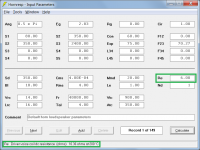Hello DamaDama,15 ohms are better for 300b setit would be best if You had 15ohm output but 8ohm will also do the job

I only have 8 and 4 ohms taps from the output transformers. In this situation, could be better 15 than 8 ohm? As far as I know, if I increase the impedance on the speaker side putting 15 ohms instead of 8, it will be reflected on the OPT side, increasing it impedance. But also will decrease the current on the OPT and speakers side.
So, my doubt is, more impedance both sides, less current on both sides, could be good sound sake?
Regards
Last edited:
FYI: Amplifier Output Impedance
Well, it's my philosophy since the thermal power [harmonic] distortion threshold is higher, but some others disagree, or at least seem to prefer this added 'richness' it can add to the recording.
GM
Well, it's my philosophy since the thermal power [harmonic] distortion threshold is higher, but some others disagree, or at least seem to prefer this added 'richness' it can add to the recording.
GM
Hello DamaDama,
I only have 8 and 4 ohms taps from the output transformers. In this situation, could be better 15 than 8 ohm? As far as I know, if I increase the impedance on the speaker side putting 15 ohms instead of 8, it will be reflected on the OPT side, increasing it impedance. But also will decrease the current on the OPT and speakers side.
So, my doubt is, more impedance both sides, less current on both sides, could be good sound sake?
Regards
They will sound less loud but only just a little bit. I've got two 15Ohm Tonsil GDS 31-21/5 elyptical speakers mounted into stupid easy OB powered with 2x2W ECL86 SE with 6 and 15 ohm outputs.
They sound superb in both 6 and 15 ohm connection but 15ohm gives them some better sound. They perform better near resonant freqeuency which is 45Hz. Generally I can say that everything below 200Hz performs better.
Heard them also with similar ECL86 with 8 and 15 Ohm outputs and had the same feelings.
If You'd have a chance to hear the difference between M15 and M8 versions driven the same way (like connected to 8Ohm output) and mounted the same way that would be great.
Regards
thanks for the link.FYI: Amplifier Output Impedance
Well, it's my philosophy since the thermal power [harmonic] distortion threshold is higher, but some others disagree, or at least seem to prefer this added 'richness' it can add to the recording.
GM
can you elaborate more on your philosophy?
cheers
Ok. The missing part on my first post is about the output voltage that is lowered when using a higher impedance than the impedance on the transformers secondary taps. But it seems that it can do a good thing on the low frequencies typical drop impedances. However it is a little different if your output transformers already has a 16 ohm tap.They will sound less loud but only just a little bit. I've got two 15Ohm Tonsil GDS 31-21/5 elyptical speakers mounted into stupid easy OB powered with 2x2W ECL86 SE with 6 and 15 ohm outputs.
They sound superb in both 6 and 15 ohm connection but 15ohm gives them some better sound. They perform better near resonant freqeuency which is 45Hz. Generally I can say that everything below 200Hz performs better.
Unfortunately, the only way to do that is acquiring a pair of M8 also. Here, these drivers are far more hard to find than in europe-If You'd have a chance to hear the difference between M15 and M8 versions driven the same way (like connected to 8Ohm output) and mounted the same way that would be great.
Regards
regards
B
thanks for the link.
can you elaborate more on your philosophy?
cheers
You're welcome!
Not much to elaborate on, I mean the more current a speaker draws, the quicker its VC heats up enough to increase its resistance, raising Qts, lowering efficiency, which in turn alters its frequency response/harmonic structure [timing].
GM
Hi GM,You're welcome!
Not much to elaborate on, I mean the more current a speaker draws, the quicker its VC heats up enough to increase its resistance, raising Qts, lowering efficiency, which in turn alters its frequency response/harmonic structure [timing].
GM
how to calculate exactly the efficiency decrease? This driver has someting like 101 Db as a reference.
My amp has 2K5 ohm primary, so connected to the 8 ohms tab, will reflect 4687.5 ohms (312.5 ratio).
Cheers
Greets!
Ugh , it's been decades since I did the math and no longer have the docs I wrote/posted or even any of the thread links.
, it's been decades since I did the math and no longer have the docs I wrote/posted or even any of the thread links.
Anyway, nowadays folks [me] just use WinISD, Hornresp or similar to plot them by increasing series resistance or if you know the heat rise temp, just use it in WinISD Pro 0.7 or any other program with the option: https://twitter.com/suurvisiiri/status/139665715740413952
GM
Ugh
Anyway, nowadays folks [me] just use WinISD, Hornresp or similar to plot them by increasing series resistance or if you know the heat rise temp, just use it in WinISD Pro 0.7 or any other program
GM
Thank you GM. I will find the way to use that software.Greets!
Anyway, nowadays folks [me] just use WinISD, Hornresp or similar to plot them by increasing series resistance or if you know the heat rise temp
GM
I would appreciate if you advise me in plain words if you think that a 15 ohms full range driver would be better than a 8 ohms with a 300b SET with 8 ohms tab transformers...while I find the way to do the math.
Regards
You're welcome!
Again, I would use 15 ohm drivers for the reason I stated, plus hooking them to 8 ohm taps further smooths out its impedance. Worst case, you have to parallel some extra resistance across the coils if you're not happy with the 'tighter' bass, which in turn reduces some of the tube amp's harmonic 'richness'.
In short, if you use the 300B for its 'lushness' and accept its somewhat 'loose' bass as the trade-off, best to use a matching impedance, i.e. 8 ohm drivers.
GM
Again, I would use 15 ohm drivers for the reason I stated, plus hooking them to 8 ohm taps further smooths out its impedance. Worst case, you have to parallel some extra resistance across the coils if you're not happy with the 'tighter' bass, which in turn reduces some of the tube amp's harmonic 'richness'.
In short, if you use the 300B for its 'lushness' and accept its somewhat 'loose' bass as the trade-off, best to use a matching impedance, i.e. 8 ohm drivers.
GM
I will find the way to use that software.
If the voice coil temperature is known, the Hornresp Power Compression tool can be used to calculate the reduction in efficiency. The black trace in Attachment 2 shows the efficiency when the voice coil temperature is 20 degrees Celsius (voice coil resistance is 6.00 ohms) and the grey trace shows the efficiency at 200 deg C (voice coil resistance is 10.36 ohms).
Attachments
Cool! A new feature? I haven't been keeping up for awhile now.
Hi GM,
The Power Compression Tool was added in Version 36.30, released November 2014.
The most recent release is Version 39.40, Product Number 3940-151028.
Kind regards,
David
Attachments
Ah! I was preoccupied most of last year and much of this one, so haven't been paying much attention. Anyway, installed the latest version and see all sorts of differences.
Thanks again for the continuing effort!
GM
Hi GM,
You're welcome. If you check the Help file, you will find lots of interesting new things to play with
Two examples attached.
Kind regards,
David
Attachments
Thanks GM. I appreciate your insights and patience. I don't have any technical training so I'm starting from the scratch with this high efficiency loudspeaker project. This is far more complicated than put together a amp kit , doing some good solder work.In short, if you use the 300B for its 'lushness' and accept its somewhat 'loose' bass as the trade-off, best to use a matching impedance, i.e. 8 ohm drivers.
GM
I want my amp sound like it's supposed to sound. Is an Audio Note Kit One, which has high gain and a good and well articulated low frequencies. It tends to distort at high volume, but I think that is common for this kind of amplifiers. I have been using for years speakers with only 91 dB sensitivity , so is an urgent need to try a high sensitivity pair. I could use 1/3 of the power, with no distortion at a good sound pressure level in a medium sized room.
Why I think in use the double of impedance? Well, at first it was only due to some comments on forums and on advertisements like the statement of coincident speakers about its 14 ohms speakers used on 8 ohms trafo tabs:
"A tube amplifier's output stage(s) are totally different. A true match between the load impedance and the plate impedance ( or plate - plate impedance of a push - pull tube output stage) is never absolutely possible.The tube's plate impedance is typically exceptionally high ( thousands of ohms.) Therefore ,even a tube output transformer ( which becomes necessary to lower the plate impedance so that a typical speaker can be driven) with a primary impedance of 3K - 8K ohms will not closely approach this match. Therefore, it can be seen that the operation of tube versus solid state outputs is reversed. In the case of transistors, impedances cannot be matched due to the ultra low output impedance of the amp ,while with tubes, the match cannot be achieved because of the very high output impedances.
The output transformer in a tube amp lowers its impedance to a level where speakers can be made to operate and extract power from the driving amplifier. The output transformer is designed with a given ratio between the number of turns of wire in the primary and a nominal secondary impedance. For example, if we connect an 8 ohm loudspeaker to an amplifier with a primary impedance of say, 5,000 ohms and a transformer tap of 8 ohms, the primary impedance remains at 5,000 ohms and the amplifier delivers a given amount of electrical power. But ,if a 4 ohm speaker is connected to this amplifier, the output volume will diminish because the 4 ohm load causes a reduction of the primary winding impedance. This reduction means the amp's output transformer presents a poorer match to the plates of the tube output stage than it previously did.
On the other hand, if a 14 ohm loudspeaker is connected to the same 8 ohm tap, the primary winding's impedance is increased. The transformer represents only a ratio of turns and its impedance is determined by the load connected to it. Because the transformer's impedance has increased, it comes closer to matching that of the plate circuit. The result is greater output volume from the speaker.
In conclusion, a tube amplifier will produce more output ( greater voltage delivery) into higher impedance loads. Therefore , a 14 ohm speaker will be much more efficiently driven by a tube amplifier than will a 8 or 4 ohm speaker. This becomes of critical importance when using OTL or single ended triode tube amplifiers when available output power is low and amplifier output impedance is very high." original text here : Coincident Speaker Technology Authorized Dealers
Also, I believe that people like Shindo use 16 ohm modified altec duplex drivers into 8 ohms amps seeking some sound benefit, etc, etc.
But, of course, it is very interesting to me to know in a rational way what is the actual physical phenomenon that are behind this kind of statements.
This Philips AD12202 drivers has about 100 dB of sensitivity, so I don't want to loose too much this advantage (and need to calculate it). But you pointed also that this supposed benefit will mean a compromise in the essence of this kind of amps, so your words are a good food for my thoughts.
Regards
Thank you David.If the voice coil temperature is known, the Hornresp Power Compression tool can be used to calculate the reduction in efficiency.
If Re is the only parameter directly related with temperature, can be calculated with your software?
This are the parameters for the AD12202 , 8 and 4 ohms version. I can't find the philips data hanbook DC04, that is the only publication where I know are described the 15 ohms version. [ the 4 ohms data]
Electric data:
nominal impedance 8 ohms [4 ohms]
*d.c. resistance of the moving coil: 6.6 ohms [3.5 ohms]
load rating (1): 100W
max load: 150W
output: 0.5W
resonant frequency: 45Hz
direct voltage (2): 9V [6.3V]
transmission range: 50Hz - 19kHz
Magnet System data:
magnet material FXD
magnet diameter 124.6mm
magnet mass 990g
energy in the air gap 498mWs
magn. flow density 1110mT(3)
air gap height 8mm
height of the moving coil 9.7mm
minor diameter 35mm
Mechanical data:
basket diameter: 313.3mm
sound opening/free space: (diameter)278/5mm
depth: 135mm
mass of the loudspeaker: 1650g
(1) measured without filter, speakers installed in div. 80 liter box
(2) in the range 35 ... 20 Hz 000
(3) 1 T (Tesla) = 10 to the power of 4 G (Gauss)
* if the Re values for the 8 and 4 ohms are 6.6 and 3.5, I can expect something around 13 or 13.5 ohms for the 15 ohms. I guess.
Regards
Attachments
Hi beto1,
Hornresp calculates the increase in voice coil resistance due to the coil being heated above the standard reference value of 20 degrees Celsius. The value of the increased voice coil resistance due to heating is displayed in the status bar panel at the bottom of the input parameters window when the mouse pointer is moved over the Re text box (see attachment).
Seems reasonable.
Kind regards,
David
If Re is the only parameter directly related with temperature, can be calculated with your software?
Hornresp calculates the increase in voice coil resistance due to the coil being heated above the standard reference value of 20 degrees Celsius. The value of the increased voice coil resistance due to heating is displayed in the status bar panel at the bottom of the input parameters window when the mouse pointer is moved over the Re text box (see attachment).
if the Re values for the 8 and 4 ohms are 6.6 and 3.5, I can expect something around 13 or 13.5 ohms for the 15 ohms. I guess.
Seems reasonable.
Kind regards,
David
Attachments
- Status
- This old topic is closed. If you want to reopen this topic, contact a moderator using the "Report Post" button.
- Home
- Loudspeakers
- Full Range
- Philips AD12202 M15
